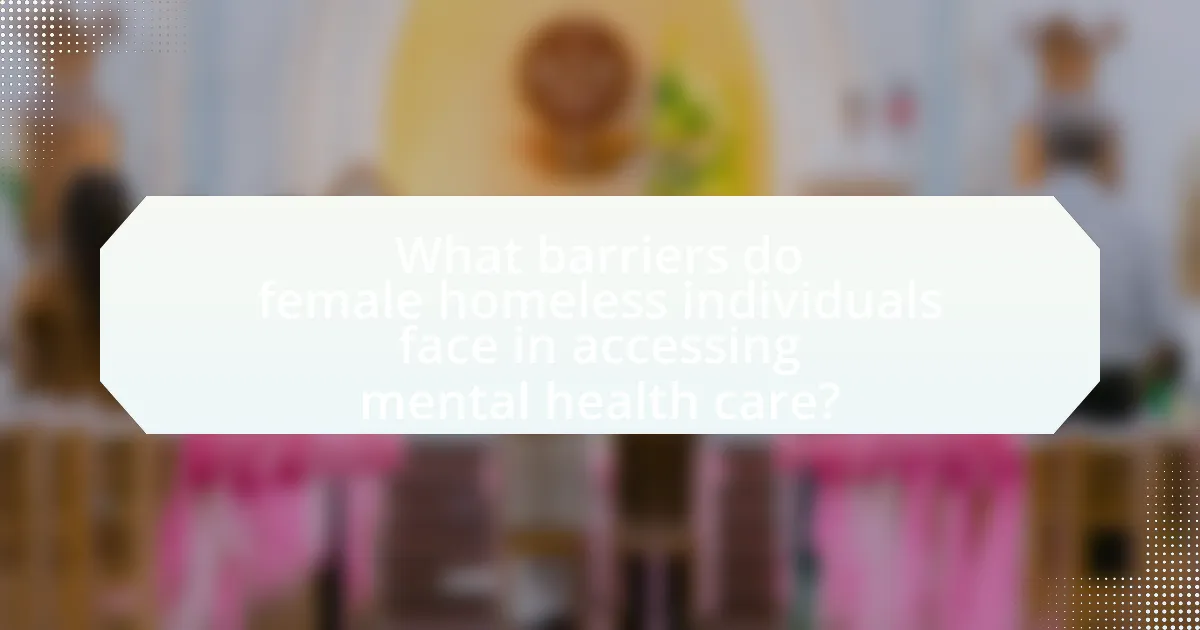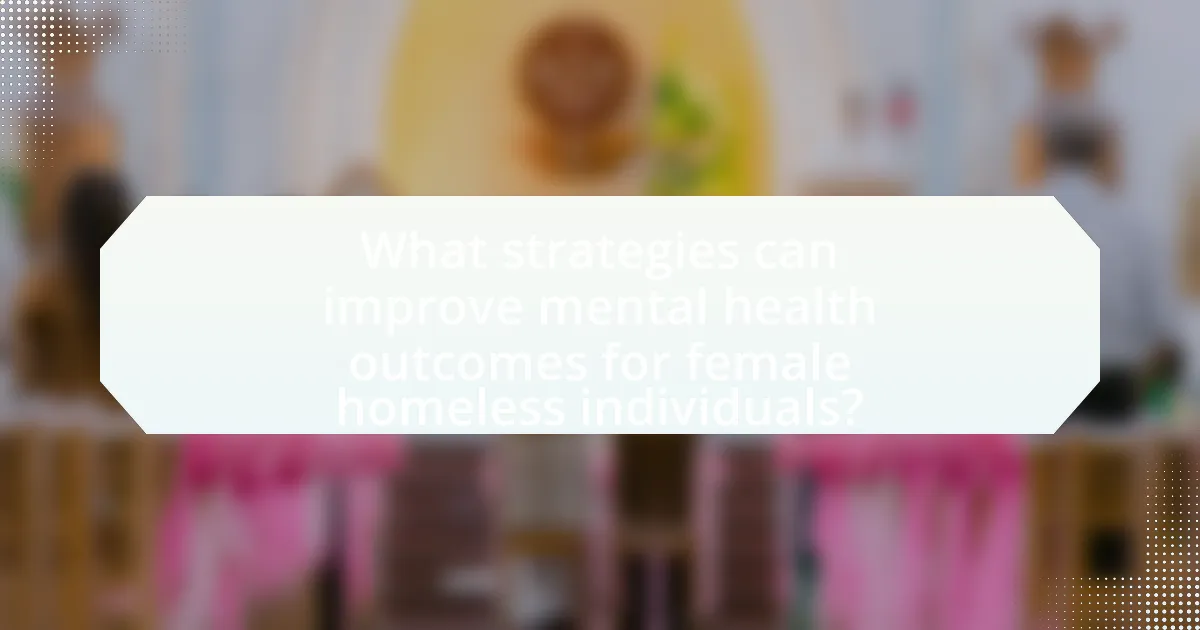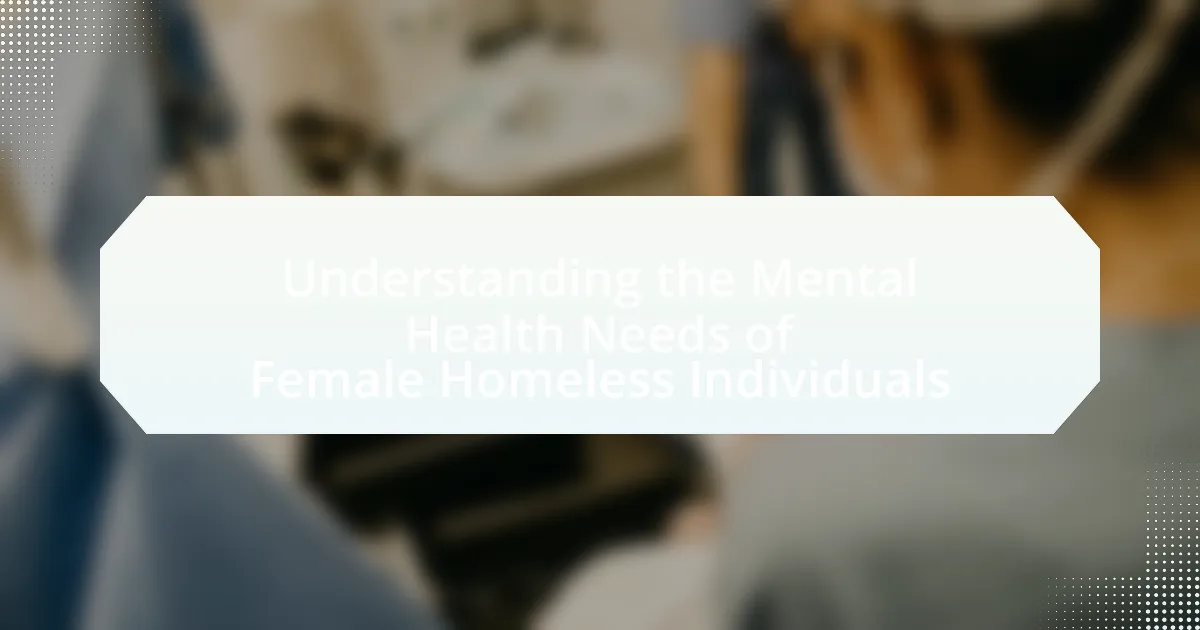The article focuses on the unique mental health needs of female homeless individuals, highlighting the prevalence of trauma, violence, and social isolation that contribute to higher rates of mental health disorders such as PTSD, depression, and anxiety. It examines how societal factors, stigma, and systemic barriers limit access to mental health care for this population. Additionally, the article discusses the intersection of substance abuse with mental health issues, the impact of trauma on well-being, and the importance of trauma-informed care and community support programs. Strategies for improving mental health outcomes, including peer support networks and targeted interventions, are also explored, emphasizing the need for comprehensive and gender-sensitive mental health services.

What are the unique mental health needs of female homeless individuals?
Female homeless individuals have unique mental health needs that often stem from experiences of trauma, violence, and social isolation. These women frequently face higher rates of post-traumatic stress disorder (PTSD), depression, and anxiety compared to their male counterparts, largely due to a history of abuse and victimization. Research indicates that approximately 80% of homeless women have experienced severe physical or sexual abuse in their lifetime, which significantly impacts their mental health. Additionally, the stigma associated with homelessness can exacerbate feelings of worthlessness and hopelessness, further complicating their mental health needs. Access to gender-sensitive mental health services is crucial, as traditional approaches may not adequately address the specific traumas and challenges faced by these women.
How do societal factors influence the mental health of female homeless individuals?
Societal factors significantly influence the mental health of female homeless individuals by exacerbating feelings of isolation, vulnerability, and trauma. For instance, societal stigma surrounding homelessness can lead to discrimination, which negatively impacts self-esteem and increases anxiety and depression among these women. Additionally, lack of access to healthcare services, often due to systemic barriers, prevents them from receiving necessary mental health support. Research indicates that approximately 30% of homeless women experience severe mental illness, often linked to experiences of violence and abuse, which are prevalent in their lives. Furthermore, economic instability and inadequate social support systems contribute to chronic stress, further deteriorating their mental health.
What role does trauma play in the mental health of female homeless individuals?
Trauma significantly impacts the mental health of female homeless individuals by increasing the prevalence of mental health disorders such as depression, anxiety, and post-traumatic stress disorder (PTSD). Research indicates that a high percentage of homeless women have experienced severe trauma, including physical and sexual abuse, which exacerbates their mental health challenges. For instance, a study published in the American Journal of Public Health found that 92% of homeless women reported experiencing trauma, leading to higher rates of mental illness compared to their male counterparts. This trauma not only affects their psychological well-being but also complicates their ability to access services and maintain stable housing, creating a cycle of homelessness and mental health issues.
How does substance abuse intersect with mental health issues among female homeless individuals?
Substance abuse significantly intersects with mental health issues among female homeless individuals, as many experience co-occurring disorders where substance use exacerbates mental health conditions. Research indicates that approximately 30% of homeless women have a substance use disorder, often linked to trauma, depression, and anxiety. For instance, a study published in the American Journal of Public Health found that women experiencing homelessness are more likely to use substances as a coping mechanism for past traumas, such as domestic violence or sexual assault. This dual struggle complicates their ability to access treatment, as mental health services may not adequately address substance use, leading to a cycle of worsening mental health and increased vulnerability.
What are the common mental health disorders faced by female homeless individuals?
Female homeless individuals commonly face mental health disorders such as depression, anxiety disorders, post-traumatic stress disorder (PTSD), and substance use disorders. Research indicates that approximately 30% of homeless women experience major depressive disorder, while anxiety disorders affect around 20% of this population. PTSD is prevalent due to high rates of trauma exposure, with studies showing that nearly 50% of homeless women report experiencing significant trauma in their lives. Additionally, substance use disorders are often co-occurring, with around 30% of homeless women struggling with addiction issues. These statistics highlight the critical mental health challenges faced by female homeless individuals, underscoring the need for targeted interventions and support services.
What is the prevalence of depression among female homeless individuals?
The prevalence of depression among female homeless individuals is estimated to be between 30% and 50%. Research indicates that this demographic experiences significantly higher rates of depression compared to the general population, which typically sees rates around 8%. A study published in the American Journal of Psychiatry found that factors such as trauma, substance abuse, and lack of social support contribute to this elevated prevalence.
How does anxiety manifest in the lives of female homeless individuals?
Anxiety manifests in the lives of female homeless individuals through heightened stress, fear of violence, and social isolation. These women often experience chronic worry about their safety, access to basic needs, and the stigma associated with homelessness. Research indicates that approximately 30% of homeless women report symptoms of anxiety disorders, which can exacerbate feelings of helplessness and depression. The lack of stable housing and support systems further intensifies their anxiety, leading to a cycle of mental health challenges that are difficult to escape.

What barriers do female homeless individuals face in accessing mental health care?
Female homeless individuals face significant barriers in accessing mental health care, including stigma, lack of transportation, and inadequate resources. Stigma surrounding mental health issues often leads to feelings of shame and reluctance to seek help, which is compounded by societal perceptions of homelessness. Additionally, many women lack reliable transportation, making it difficult to reach mental health facilities. Furthermore, the availability of mental health services is often limited, with many programs not tailored to the specific needs of homeless women, such as trauma-informed care. According to a study published in the American Journal of Public Health, nearly 30% of homeless women reported unmet mental health needs, highlighting the systemic issues that hinder access to necessary care.
How does stigma affect the willingness of female homeless individuals to seek help?
Stigma significantly reduces the willingness of female homeless individuals to seek help. This reduction occurs because stigma creates feelings of shame and fear of judgment, leading many women to avoid services that could assist them. Research indicates that 70% of homeless women report feeling stigmatized, which correlates with lower rates of engagement in mental health services. Additionally, the fear of being labeled as “undeserving” or “unworthy” further discourages these women from reaching out for necessary support, as highlighted in studies conducted by the National Alliance to End Homelessness.
What misconceptions exist about mental health among female homeless populations?
Misconceptions about mental health among female homeless populations include the belief that mental illness is the primary cause of homelessness and that all homeless women have severe mental health issues. In reality, while mental health challenges are prevalent, studies indicate that factors such as economic hardship, domestic violence, and lack of affordable housing are significant contributors to homelessness. For instance, the National Alliance to End Homelessness reports that many women experience homelessness due to situational factors rather than chronic mental health conditions. Additionally, stigma surrounding mental health can lead to the assumption that homeless women are dangerous or incapable of recovery, which undermines their potential for rehabilitation and support.
How do financial constraints limit access to mental health services for female homeless individuals?
Financial constraints significantly limit access to mental health services for female homeless individuals by restricting their ability to afford treatment and related expenses. Many female homeless individuals lack stable income and health insurance, which are critical for accessing mental health care. According to the National Alliance to End Homelessness, approximately 30% of homeless women report mental health issues, yet the high costs of therapy, medication, and transportation create barriers to receiving necessary support. Additionally, the lack of affordable housing exacerbates these financial constraints, as women often prioritize basic needs over mental health services, further limiting their access to care.
What systemic issues contribute to the lack of mental health resources for female homeless individuals?
Systemic issues contributing to the lack of mental health resources for female homeless individuals include inadequate funding for mental health services, societal stigma surrounding mental illness, and insufficient integration of services. Funding for mental health programs is often limited, leading to a scarcity of resources specifically tailored for women experiencing homelessness. Additionally, societal stigma can deter women from seeking help, as they may fear judgment or discrimination. Furthermore, the lack of coordinated services means that mental health care is not effectively integrated with housing and social services, making it difficult for female homeless individuals to access the comprehensive support they need. These factors collectively hinder the availability and accessibility of mental health resources for this vulnerable population.
How do housing instability and lack of support networks impact mental health care access?
Housing instability and lack of support networks significantly hinder access to mental health care. Individuals experiencing housing instability often face barriers such as financial strain, lack of transportation, and uncertainty about their living situation, which can prevent them from seeking or maintaining consistent mental health treatment. Research indicates that homeless individuals are more likely to experience mental health disorders, yet they often lack the social support necessary to navigate healthcare systems effectively. For instance, a study published in the American Journal of Public Health found that individuals without stable housing are less likely to receive mental health services compared to those with stable housing, highlighting the critical role of both housing stability and social support in facilitating access to care.
What role do healthcare policies play in addressing the needs of female homeless individuals?
Healthcare policies play a crucial role in addressing the needs of female homeless individuals by ensuring access to essential medical services, mental health care, and supportive resources. These policies often include provisions for comprehensive healthcare coverage, which can help mitigate the barriers that female homeless individuals face, such as lack of insurance and limited access to facilities. For instance, the Affordable Care Act expanded Medicaid eligibility, allowing more low-income individuals, including homeless women, to receive necessary health services. Additionally, targeted programs within healthcare policies, such as those focusing on mental health and substance abuse treatment, specifically address the unique challenges faced by this demographic, as studies indicate that women experiencing homelessness are at a higher risk for mental health issues. By integrating these services into healthcare policies, governments can better support the physical and mental well-being of female homeless individuals, ultimately leading to improved health outcomes and stability.

What strategies can improve mental health outcomes for female homeless individuals?
Comprehensive mental health support programs can significantly improve mental health outcomes for female homeless individuals. These programs should include trauma-informed care, which recognizes the impact of trauma on mental health and provides appropriate support. Research indicates that approximately 80% of homeless women have experienced trauma, highlighting the need for specialized interventions. Additionally, integrating mental health services with housing assistance can address both psychological and social needs, leading to better overall outcomes. A study published in the American Journal of Public Health found that access to stable housing combined with mental health services reduced psychiatric symptoms in homeless women by 50%. Furthermore, peer support groups can foster community and resilience, as shared experiences often lead to improved coping strategies and reduced feelings of isolation.
How can community programs effectively support the mental health of female homeless individuals?
Community programs can effectively support the mental health of female homeless individuals by providing tailored mental health services, safe housing options, and social support networks. These programs can offer access to counseling, therapy, and psychiatric care specifically designed to address the unique trauma and mental health challenges faced by women experiencing homelessness. Research indicates that women in this demographic often experience higher rates of mental health disorders, such as depression and anxiety, exacerbated by factors like domestic violence and substance abuse. For instance, a study published in the American Journal of Public Health found that 30% of homeless women reported experiencing severe mental illness, highlighting the need for targeted interventions. By integrating mental health services with housing assistance and community support, programs can create a holistic approach that fosters recovery and stability for female homeless individuals.
What types of interventions have proven successful in addressing mental health needs?
Successful interventions for addressing mental health needs include cognitive-behavioral therapy (CBT), supportive housing programs, and integrated care models. Research indicates that CBT effectively reduces symptoms of anxiety and depression among individuals experiencing homelessness, as demonstrated in a study published in the Journal of Consulting and Clinical Psychology, which found a significant decrease in mental health symptoms among participants receiving CBT. Supportive housing programs, which combine stable housing with mental health services, have shown to improve overall well-being and reduce psychiatric symptoms, as evidenced by a study in the American Journal of Psychiatry that reported a 50% reduction in psychiatric hospitalizations among participants. Integrated care models, which provide mental health services alongside primary care, have also proven effective, with a study in the Journal of the American Medical Association highlighting improved mental health outcomes and increased access to care for homeless individuals.
How can peer support networks enhance mental health recovery for female homeless individuals?
Peer support networks can enhance mental health recovery for female homeless individuals by providing emotional support, shared experiences, and practical resources. These networks foster a sense of belonging and reduce feelings of isolation, which are critical for mental well-being. Research indicates that peer support can lead to improved coping strategies and increased engagement in treatment, as individuals feel understood and validated by those with similar experiences. A study published in the Journal of Community Psychology found that participants in peer support programs reported significant reductions in symptoms of depression and anxiety, highlighting the effectiveness of these networks in promoting recovery among vulnerable populations.
What role does trauma-informed care play in supporting female homeless individuals?
Trauma-informed care plays a crucial role in supporting female homeless individuals by recognizing the widespread impact of trauma on their lives and tailoring services to meet their specific needs. This approach fosters a safe environment that promotes trust, empowerment, and healing, which is essential for women who have often experienced violence, abuse, or neglect. Research indicates that approximately 80% of homeless women have experienced severe trauma, highlighting the necessity of trauma-informed practices in shelters and support services. By integrating trauma-informed care, providers can improve mental health outcomes, reduce re-traumatization, and enhance overall well-being for female homeless individuals.
How can mental health professionals implement trauma-informed practices in their work?
Mental health professionals can implement trauma-informed practices by prioritizing safety, trustworthiness, and empowerment in their interactions with clients. This approach involves recognizing the prevalence of trauma among female homeless individuals and integrating this understanding into all aspects of care. For instance, professionals can create a welcoming environment that fosters a sense of safety, ensuring that clients feel secure both physically and emotionally. Additionally, training staff on trauma awareness and the impact of trauma on behavior can enhance the effectiveness of interventions. Research indicates that trauma-informed care can lead to improved outcomes, such as increased engagement and reduced symptoms, as evidenced by studies showing that clients report higher satisfaction and better mental health when treated in a trauma-informed manner.
What training is necessary for service providers to better assist female homeless individuals?
Service providers need training in trauma-informed care, mental health awareness, and gender-specific issues to better assist female homeless individuals. Trauma-informed care equips providers with the understanding that many women experiencing homelessness have faced significant trauma, which affects their mental health and coping mechanisms. Mental health awareness training helps providers recognize and address common mental health issues such as depression and anxiety that disproportionately affect homeless women. Additionally, training on gender-specific issues ensures that providers are sensitive to the unique challenges faced by women, including safety concerns and access to reproductive health services. Research indicates that such targeted training improves service delivery and outcomes for female homeless populations, as highlighted in studies by the National Alliance to End Homelessness.
What practical steps can female homeless individuals take to improve their mental health?
Female homeless individuals can improve their mental health by accessing supportive services, engaging in social connections, and practicing self-care. Accessing supportive services, such as mental health counseling and substance abuse treatment, provides essential resources for coping with trauma and stress. Engaging in social connections, whether through community groups or shelters, fosters a sense of belonging and reduces feelings of isolation, which is crucial for mental well-being. Practicing self-care activities, such as maintaining hygiene, exercising, and pursuing hobbies, can enhance mood and overall mental health. Research indicates that social support and self-care practices significantly contribute to improved mental health outcomes among homeless populations, highlighting the importance of these practical steps.

Leave a Reply